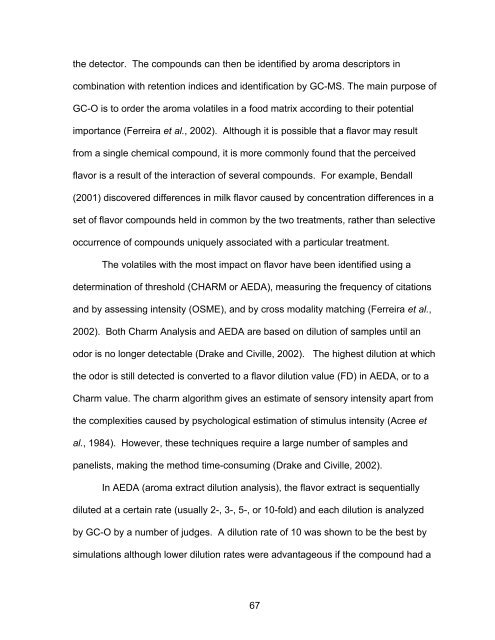Abstract SCHIRACK, ANDRIANA VAIS. The Effect of Microwave ...
Abstract SCHIRACK, ANDRIANA VAIS. The Effect of Microwave ...
Abstract SCHIRACK, ANDRIANA VAIS. The Effect of Microwave ...
Create successful ePaper yourself
Turn your PDF publications into a flip-book with our unique Google optimized e-Paper software.
the detector. <strong>The</strong> compounds can then be identified by aroma descriptors in<br />
combination with retention indices and identification by GC-MS. <strong>The</strong> main purpose <strong>of</strong><br />
GC-O is to order the aroma volatiles in a food matrix according to their potential<br />
importance (Ferreira et al., 2002). Although it is possible that a flavor may result<br />
from a single chemical compound, it is more commonly found that the perceived<br />
flavor is a result <strong>of</strong> the interaction <strong>of</strong> several compounds. For example, Bendall<br />
(2001) discovered differences in milk flavor caused by concentration differences in a<br />
set <strong>of</strong> flavor compounds held in common by the two treatments, rather than selective<br />
occurrence <strong>of</strong> compounds uniquely associated with a particular treatment.<br />
<strong>The</strong> volatiles with the most impact on flavor have been identified using a<br />
determination <strong>of</strong> threshold (CHARM or AEDA), measuring the frequency <strong>of</strong> citations<br />
and by assessing intensity (OSME), and by cross modality matching (Ferreira et al.,<br />
2002). Both Charm Analysis and AEDA are based on dilution <strong>of</strong> samples until an<br />
odor is no longer detectable (Drake and Civille, 2002). <strong>The</strong> highest dilution at which<br />
the odor is still detected is converted to a flavor dilution value (FD) in AEDA, or to a<br />
Charm value. <strong>The</strong> charm algorithm gives an estimate <strong>of</strong> sensory intensity apart from<br />
the complexities caused by psychological estimation <strong>of</strong> stimulus intensity (Acree et<br />
al., 1984). However, these techniques require a large number <strong>of</strong> samples and<br />
panelists, making the method time-consuming (Drake and Civille, 2002).<br />
In AEDA (aroma extract dilution analysis), the flavor extract is sequentially<br />
diluted at a certain rate (usually 2-, 3-, 5-, or 10-fold) and each dilution is analyzed<br />
by GC-O by a number <strong>of</strong> judges. A dilution rate <strong>of</strong> 10 was shown to be the best by<br />
simulations although lower dilution rates were advantageous if the compound had a<br />
67

















